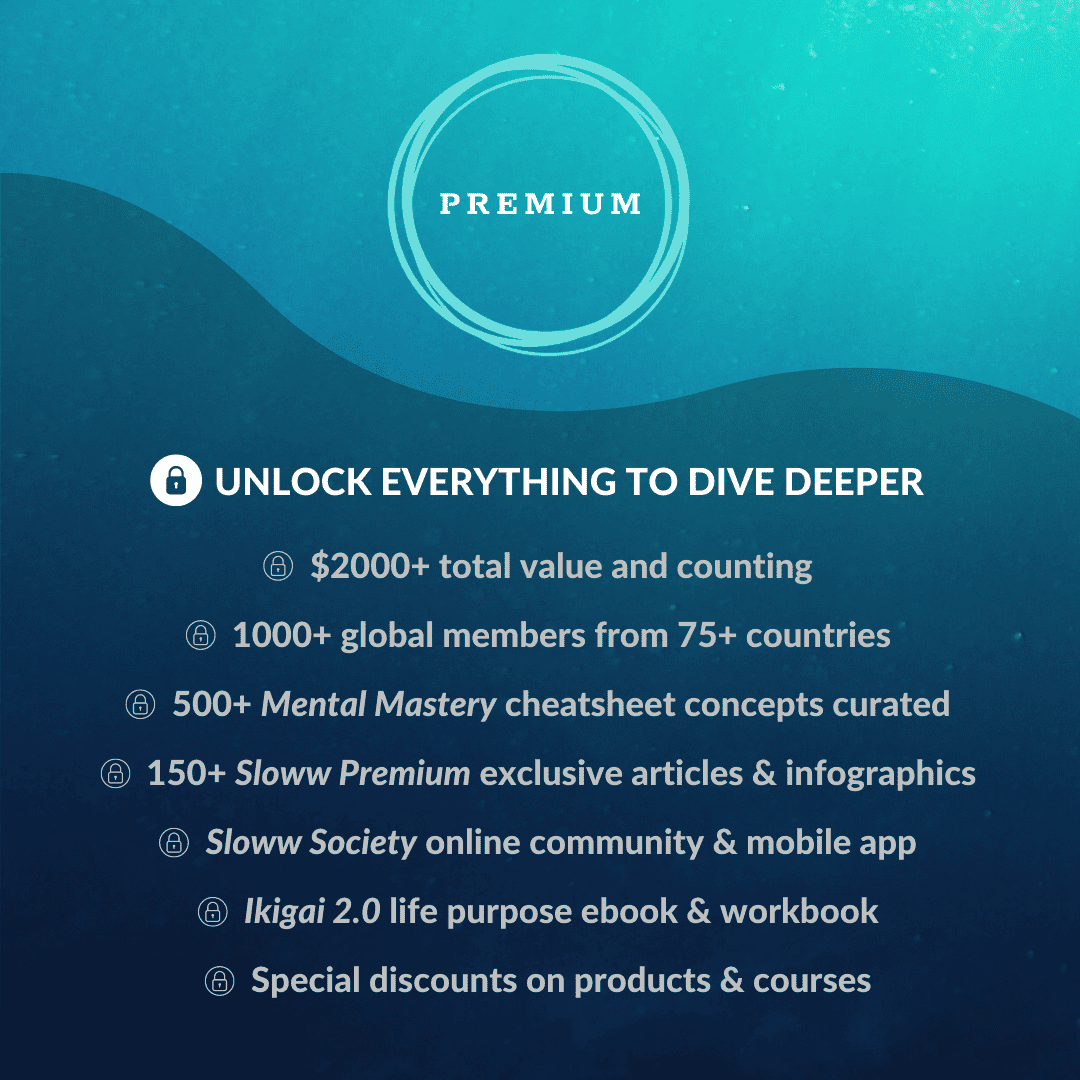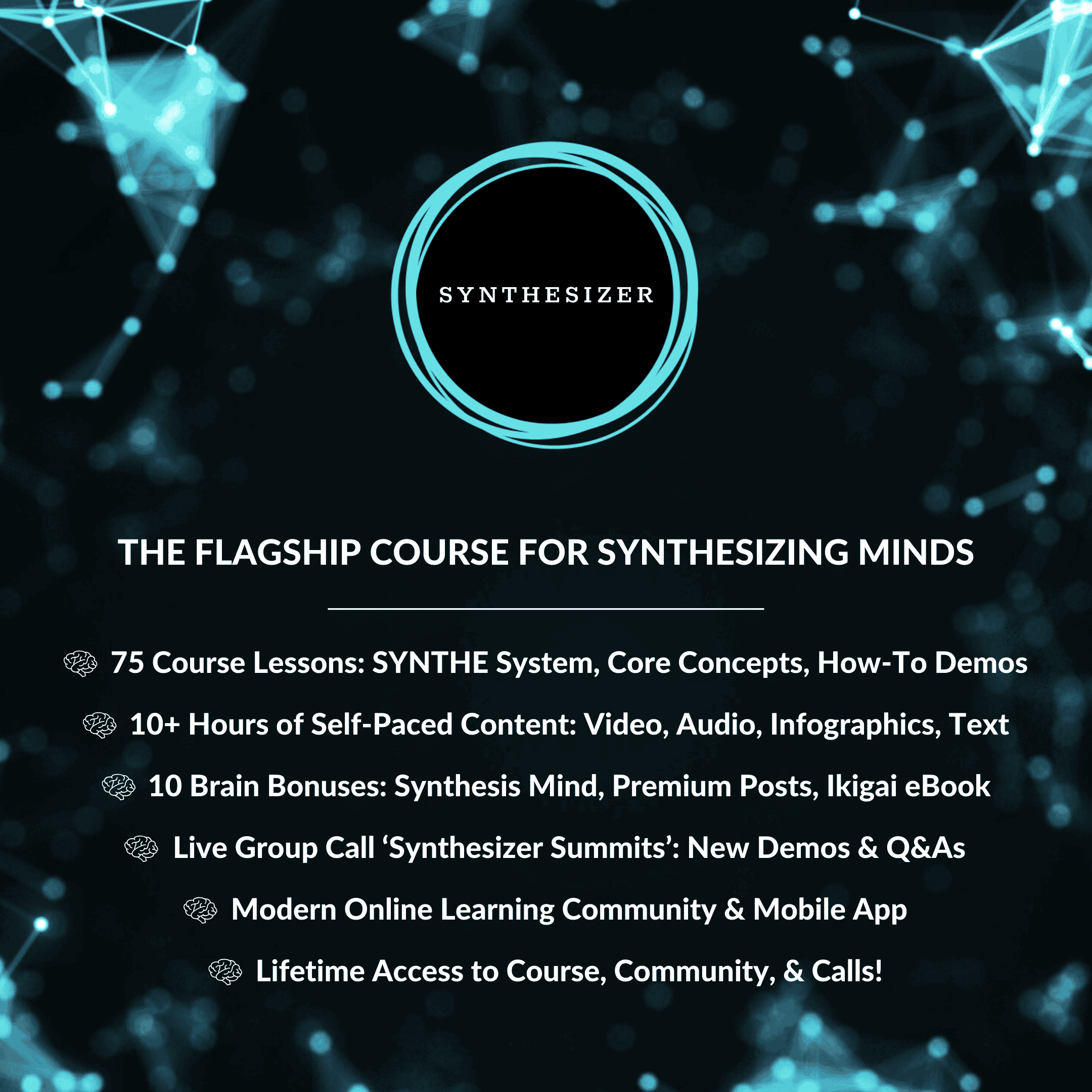This is the first post in an ikigai series. Links to the remainder of the series are listed at the bottom of this post.
The True Meaning of Ikigai: Definitions, Diagrams & Myths about the Japanese Life Purpose
Ikigai. You’ve probably seen the word. Or, maybe you’ve seen the four-circle diagram. Needless to say, it’s a hot topic today.
But, what is ikigai really? Like most things, there’s a lot of misinformation floating around on the internet. My hope with this post is to give you the truth about ikigai.
Before we dive in too deep, let’s start with the correct pronunciation. After studying the concept for a bit, my understanding is that the correct pronunciation of ikigai is ee-kee-guy (not icky-guy or eye-key-guy).
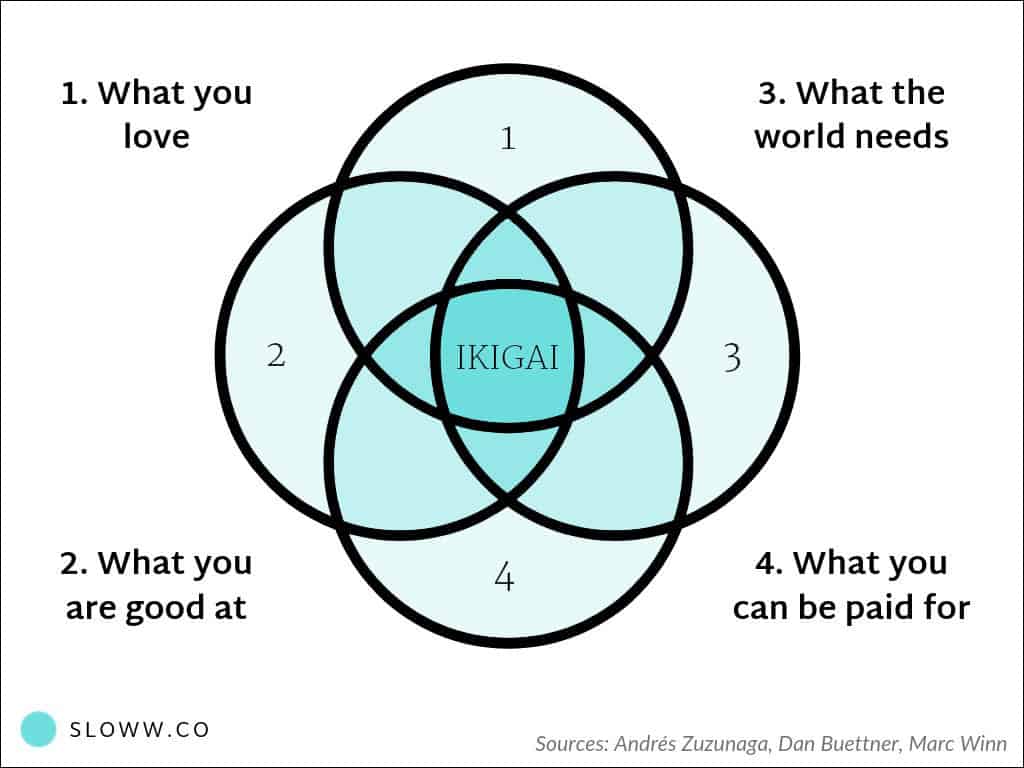
The Origin of Ikigai & Rise in Popularity
The earliest online mention I can find of ikigai is from 1996—Gordon Mathews published a book titled What Makes Life Worth Living? How Japanese and Americans Make Sense of Their Worlds (you can access a sample of this book in footnote 1). Mathews first came across the word ikigai in the 1980s while living in Japan and believes:
- “The term has a long history, appearing as far back as the fourteenth-century Taiheiki, as well as in such early twentieth-century works as Natsume Sōseki’s 1912 novel Kōjin; but the contemporary Japanese works on ikigai that I’ve studied say little about the history of the term or about ikigai as conceived in the past.”¹
In 1999, a paper was published in Age and Ageing titled “‘Ikigai’ in older Japanese people”². This short article has some great insights that I’ve included in this post—it provides a unique perspective on ikigai before the turn of the century, social media proliferation, and the Westernization of the term.
A decade later in 2009, Dan Buettner gave a TED Talk about his research on the Blue Zones—this officially catapulted ikigai into mainstream popularity. I’ve previously investigated the Ikarians from the Blue Zone in Ikaria, Greece, but ikigai comes from the Blue Zone in Okinawa, Japan.
We’ll dive into the various ikigai definitions and diagrams, but what makes this concept so popular?
- “The desire for what the Japanese call ikigai is a universal human experience.”
- “Ikigai, which is the highest level of desire, may be considered to be essentially the processes of cultivating one’s inner potential or that which makes one’s life significant.”
- “Needs associated with ikigai are not simply equal to the desires for biological satisfaction or the desires of humans as social creatures. They are individual desires of humans as spiritual beings.”²
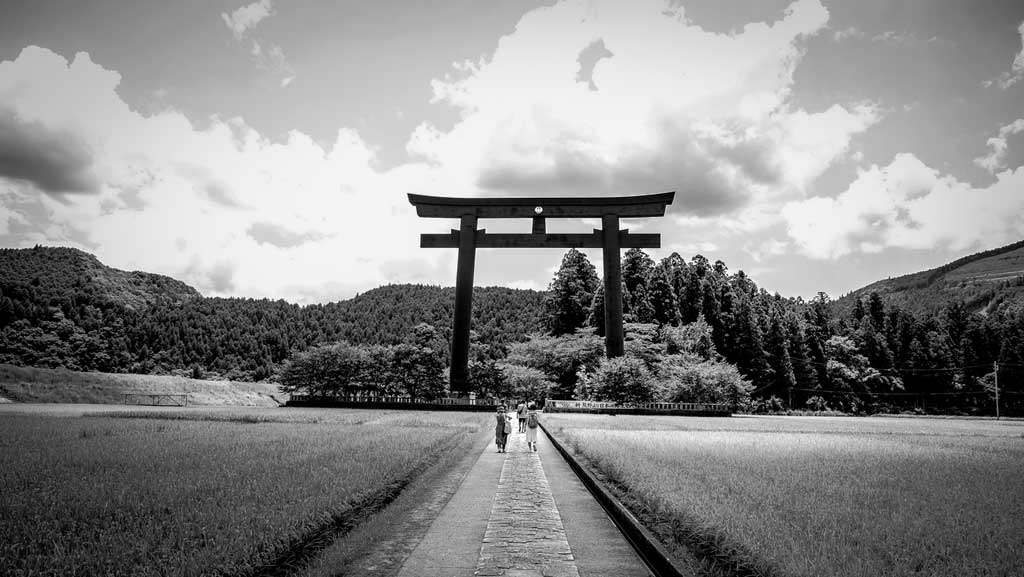
The Definition of Ikigai
There’s no direct translation of ikigai into English, but the most legitimate definitions I’ve found are the following (emphasis added in bold):
- “The term ikigai is composed of: iki and kai. At present, kai is generally written in hiragana (Japanese phonetic syllabery)… Iki refers to ‘life‘; kai is a suffix meaning roughly ‘the realization of what one expects and hopes for.'”¹
- “Japanese dictionaries define ikigai in such terms as ikiru hariai, yorokobi, meate (something to live for, the joy and goal of living) and ikite iru dake no neuchi, ikite inu kōfuku, rieki (a life worth living, the happiness and benefit of being alive).”¹
This is pretty close to how Wikipedia describes it as well:
- “The term ikigai compounds two Japanese words: iki meaning ‘life; alive‘ and kai meaning ‘(an) effect; (a) result; (a) fruit; (a) worth; (a) use; (a) benefit; (no, little) avail’ (sequentially voiced as gai) to arrive at ‘a reason for living (being alive); a meaning for (to) life; what (something that) makes life worth living; a raison d’etre‘.”³
I’ve also seen ikigai translated as:
- “reason for being”
- “the reason for which you wake up in the morning”
- “The direct translation is the ‘happiness of being busy.'”4 (Note: I’ll assume they mean living a full life vs busy life)
After rereading the bolded areas above, what if we were to view ikigai like this:
As far as descriptions go, here are a couple I resonate with:
- “The process of allowing the self’s possibilities to blossom.”³ (Note: This is even more powerful if you visualize the ikigai diagram as a flower blooming)
- “This word (ikigai) is really like a treasure map. And, this treasure map can help you find your way to finding wonderful things about yourself that you can share with the world, and the world will say ‘thank you’ for it.” — Tim Tamashiro (Note: You can watch his TED Talk at the bottom of this post; he has boiled down his own ikigai to two words: “To delight”)
The Truth about the Ikigai Diagram
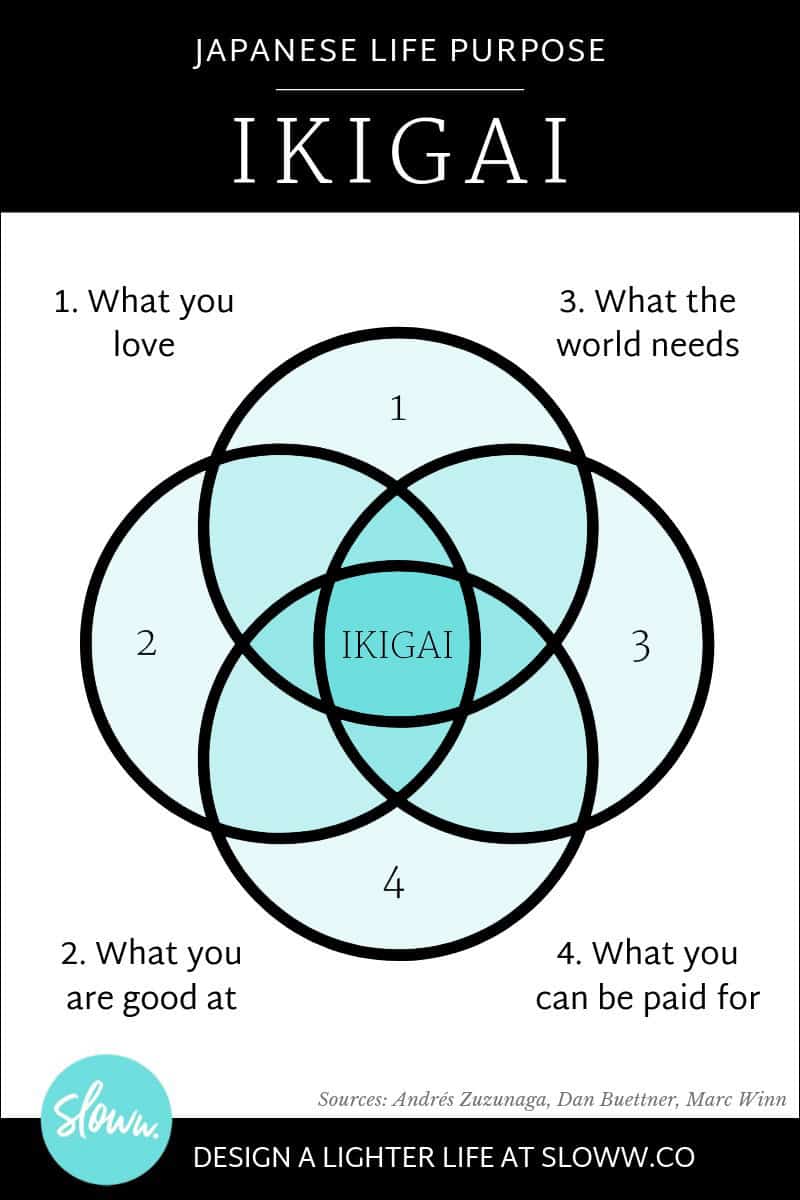
Most people associate ikigai with the four-circle diagram created by Marc Winn in 20146:
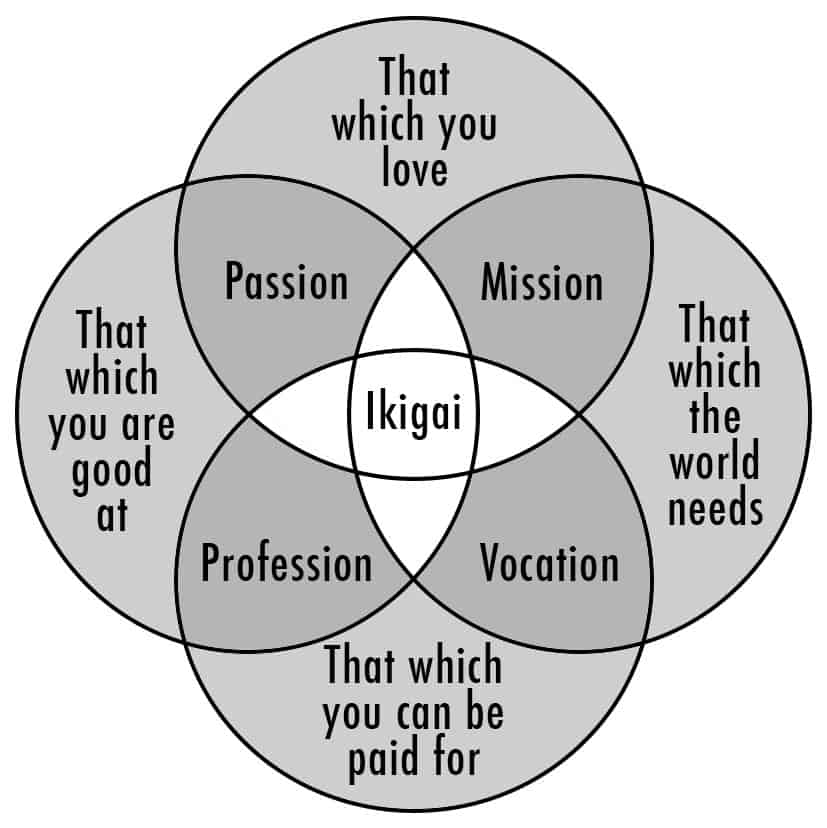
But, three years after creating the diagram, Marc revealed the truth:
- “In 2014, I wrote a blog post on the subject of Ikigai. In that blog post, I merged two concepts to create something new. Essentially, I merged a venn diagram on ‘purpose’ with Dan Buettner’s Ikigai concept, in relation to living to be more than 100. The sum total of my effort was that I changed one word on a diagram and shared a ‘new’ meme with the world.”7
Changed one word on a diagram? What is the venn diagram on purpose that he mentioned? Winn confirmed he sourced it from Andrés Zuzunaga who originally created the graphic in Spanish two years earlier. Winn said:
- “I can confirm that over the years the crowd has indicated that this is indeed the original source of the venn diagram on purpose. My role was merely to merge the concept of Ikigai with this already defined concept of purpose.”
Here’s Andrés Zuzunaga’s purpose diagram8:

So, is Zuzunaga the original? Well, that’s tricky too.
All of this is eerily similar to the Hedgehog Concept created by Jim Collins in his book Good to Great which was published in 2001:
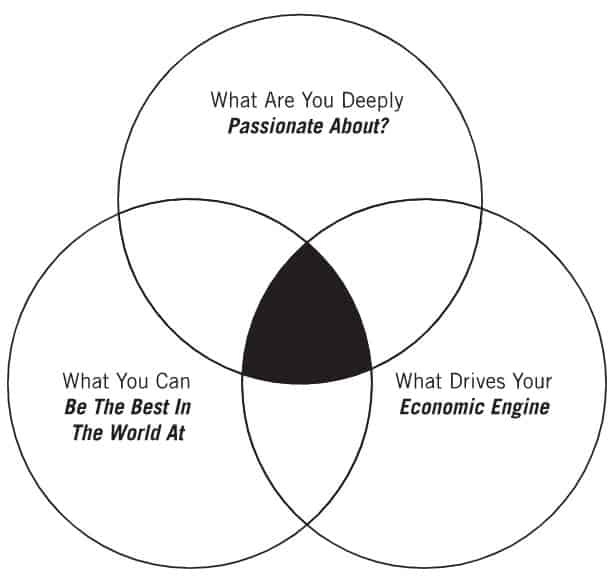
Since publishing Good to Great, Jim Collins has updated the Hedgehog Concept—which was originally intended for businesses—to apply to people.
I compared the Hedgehog Concept vs Ikigai. Here’s what that looks like:
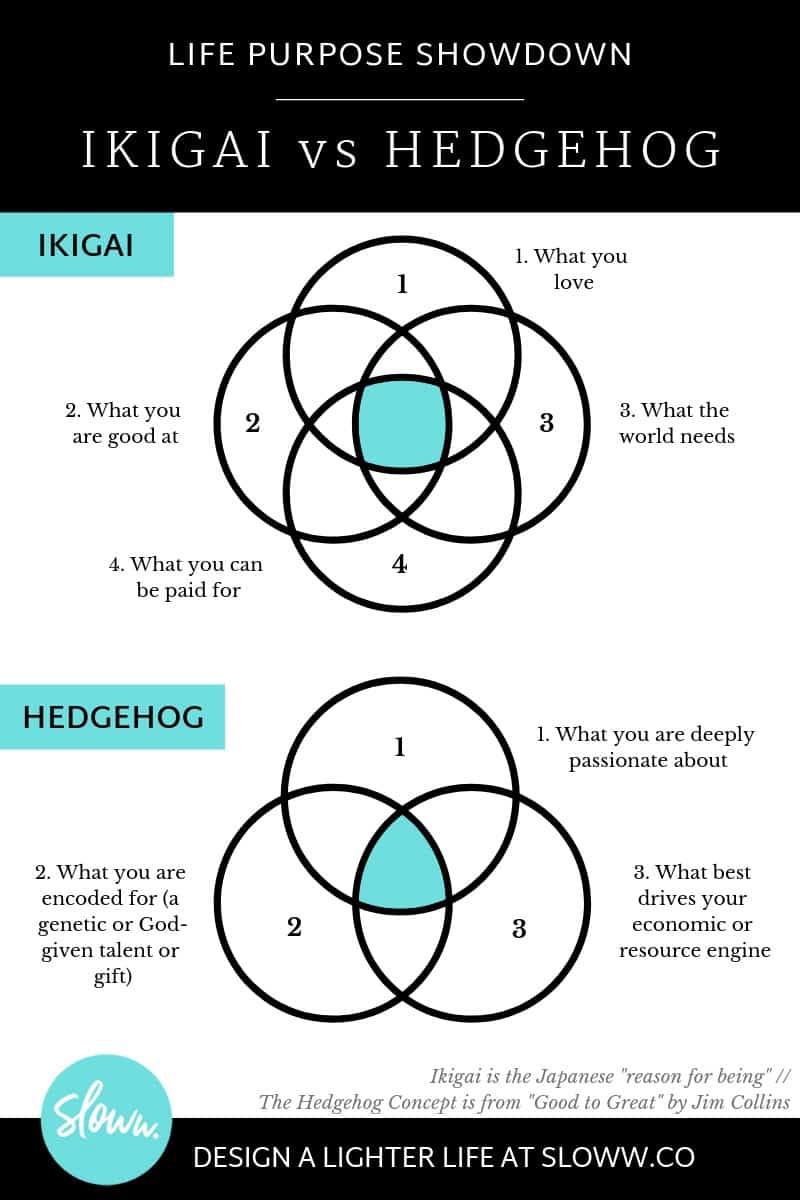
Given the amount of research Jim Collins puts into his work, I wouldn’t be surprised if his version is the most “original” of all. At the same time, his work is the result of his own curating, synthesizing, and insight gathering—all of which have influenced his Hedgehog Concept. So, I think we can just conclude that everything is a remix of something else.
Ikigai Myths: Addressing 3 Big Misperceptions about Ikigai in the West
Ikigai isn’t necessarily about your work (you weren’t born to work):
- “In a survey of 2,000 Japanese men and women conducted by Central Research Services in 2010, just 31% of recipients considered work as their ikigai. Someone’s value in life can be work – but is certainly not limited to that.” — BBC9
There is evidence in the fact that many Japanese people keep pursuing their ikigai until the end of their lives:
- “Many Japanese people never really retire—they keep doing what they love for as long as their health allows.”10
Other than work, ikigai can be family, a dream, or simply the spiritual feeling that life is worth living:
- “Ikigai may be conceived of either as the ‘object’ that makes one’s life seem worth living (ikigai taishō)—one’s work or family or dream—or as the feeling that life is worth living (ikigai kan).”¹
- “The word ‘ikigai’ is usually used to indicate the source of value in one’s life or the things that make one’s life worthwhile (for example, one might say: ‘This child is my ikigai’). Secondly, the word is used to refer to mental and spiritual circumstances under which individuals feel that their lives are valuable.”²
This is a big difference compared to other models for life purpose. For instance, Simon Sinek and his co-authors of Find Your Why say:
- “The bottom line is your family is not your WHY.”
I disagree with them. Instead, I agree with Oprah in her book The Path Made Clear when she says:
- “Your purpose doesn’t have to be tied to your career. I have many friends who told me they knew they were meant to have children before they even understood what it was to conceive. I’ve always believed that accepting the call to be a mother is the choice to become the ultimate spiritual teacher. Because mothers live in service and sacrifice to their children.”
Naturally, if your ikigai doesn’t have to be work-related, then money can (and should) be removed from the diagram. Along with the perception that ikigai relates to work, the circle for “that which you can be paid for” gets a lot of criticism for being a misinterpretation by Westerners:
- “Finding the answers and a balance between these four areas could be a route to ikigai for Westerners looking for a quick interpretation of this philosophy. But in Japan, ikigai is a slower process and often has nothing to do with work or income.” — Laura Oliver11
- “Ikigai gives individuals a sense of a life worth living. It is not necessarily related to economic status. Behaviours which make one feel ikigai are not actions which individuals are forced to take, but they are spontaneous activities which people undertake willingly. Ikigai is personal; it reflects the inner self of an individual and expresses that faithfully. It establishes a unique mental world in which the individual can feel at ease.”²
Some, like Tim Tamashiro, believe this could be reframed as “what you can be rewarded for.”
There’s no shortage of people out there who want to convince you that you have one life purpose and one life purpose only. This can be incredibly overwhelming for people as they try to find their one and only purpose.
What I’ve learned is that:
- “Ikigai is not something grand or extraordinary. It’s something pretty matter-of-fact.” — Gordon Mathews, professor of anthropology11
- “You don’t need huge ambition to be very happy, you just need a bunch of friends to drink green tea and talk with. Get rid of the mess and at the core is your ikigai.” — Héctor García12
It’s about the process vs the final aim:
- “I have learned in my own research with older Japanese, what makes ikigai effective is its inextricable link to a sense of mastery – the idea known as ‘chanto suru’ that things should be done properly. As such, ikigai emphasises process and immersion rather than a final aim.” —
One thing to keep in mind is that you can edit your life purpose at any age. It’s natural that your purpose will evolve over time:
- “They have an important purpose in life, or several. They have an ikigai, but they don’t take it too seriously. They are relaxed and enjoy all that they do.”10
Ikigai Tips to Get You Started
I’ve also read the top-reviewed book currently available on ikigai: Ikigai: The Japanese Secret to a Long and Happy Life by Héctor García and Francesc Miralles.
After interviewing one hundred centenarians and supercentenarians in Ogimi, Okinawa to try to understand their life philosophy and longevity secrets, the authors developed their ten rules of ikigai:
- Stay active; don’t retire.
- Take it slow.
- Don’t fill your stomach.
- Surround yourself with good friends.
- Get in shape for your next birthday.
- Smile.
- Reconnect with nature.
- Give thanks.
- Live in the moment.
- Follow your ikigai.

Bonus: Of all the ikigai TED Talks and YouTube videos, here’s one that is simple and worth watching:
Have you found your ikigai? If so, please let me know what it is in the comments.
You May Also Enjoy:
- Get my new eBook: Ikigai 2.0: A Step-by-Step Guidebook to Finding Life Purpose & Making Money Meaningfully (+ Bonus Workbook)
- Ikigai 2.0: Evolving the Ikigai Diagram for Life Purpose (& Why and How it Needs to be Redesigned)
- My Ikigai 2.0 — A Detailed Personal Ikigai Example of How to Find Your Life Purpose
- “Ikigai: The Japanese Secret to a Long and Happy Life” by Héctor García and Francesc Miralles (Book Summary)
- How the Japanese Wake Up to Joy and Purpose: “Awakening Your Ikigai” by Ken Mogi (Book Summary)
Footnotes:
- https://books.google.com/books?id=20kAa87zzUYC&pg=PA3&source=gbs_toc_r&cad=4#v=onepage&q&f=false
- https://academic.oup.com/ageing/article/28/3/323/31016
- https://en.wikipedia.org/wiki/Ikigai
- https://informationisbeautiful.net/visualizations/ikigai-japanese-concept-to-enhance-work-life-sense-of-worth/
- https://www.ucpress.edu/book.php?isbn=9780520201330
- http://theviewinside.me/what-is-your-ikigai/
- http://theviewinside.me/meme-seeding/
- https://www.cosmograma.com/proposito.php
- http://www.bbc.com/capital/story/20170807-ikigai-a-japanese-concept-to-improve-work-and-life
- https://www.sloww.co/ikigai-book/
- https://www.weforum.org/agenda/2017/08/is-this-japanese-concept-the-secret-to-a-long-life/
- https://theculturetrip.com/asia/japan/articles/ikigai-the-japanese-secret-to-a-long-happy-life/
- https://theconversation.com/the-japanese-concept-of-ikigai-why-purpose-might-be-a-better-goal-than-happiness-88709



